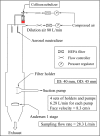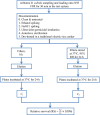Relative survival of Bacillus subtilis spores loaded on filtering facepiece respirators after five decontamination methods
- PMID: 29855107
- PMCID: PMC7165566
- DOI: 10.1111/ina.12475
Relative survival of Bacillus subtilis spores loaded on filtering facepiece respirators after five decontamination methods
Abstract
This study determines the relative survival (RS) of Bacillus subtilis spores loaded on an N95 filtering facepiece respirator (FFR) after decontamination by five methods under worst-case conditions. Relative survival was obtained by testing after decontamination and after storing the FFRs at 37°C and 95% relative humidity for 24 hours. The decontamination methods involved ethanol, bleach, ultraviolet irradiation (UVA 365 nm, UVC 254 nm), an autoclave, and a traditional electric rice cooker (TERC) that was made in Taiwan. Without decontamination, 59 ± 8% of the loaded spores survived for 24 hours. When 70% ethanol was added to the N95 FFR at a packing density of 0.23, the RS was 73 ± 5% initially and decayed to 22 ± 8% in 24 hours. Relative survival remained above 20% after 20 minutes of UVA irradiation. The other four decontamination measures achieved 99%-100% biocidal efficacy, as measured immediately after the methods were applied to the test FFRs. Relative survival is a useful parameter for measuring sterilization or degree of disinfection. Bleach, UVC, an autoclave, and a TERC provide better biocidal efficacy than ethanol and UVA. Not only a higher filter quality but also a lower value of RS produced the most decontaminated FFR.
Keywords: N95; bioefficacy; decontamination; respirator; spore; survive.
© 2018 John Wiley & Sons A/S. Published by John Wiley & Sons Ltd.
Figures







References
-
- National Institute for Occupational Safety and Health (NIOSH) . Recommended guidance for extended use and limited reuse of N95 filtering facepiece respirators in healthcare settings. 2014.
-
- Nazaroff WW, Nicas M, Miller SL. Framework for evaluating measures to control nosocomial tuberculosis transmission. Indoor Air. 1998;8:205‐218.
LinkOut - more resources
Full Text Sources
Other Literature Sources

